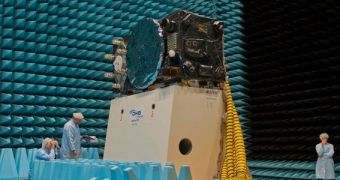Officials with the European Space Agency (ESA) announce that another one of its Galileo satellites has completed cryogenic space testing in Europe, and is now one step closer to launch. The vehicle underwent rigorous assessments in a specialized facility for more than five weeks.
The tests concluded on Friday, November 27, when the Galileo spacecraft was removed from Phoenix, a test chamber with a diameter of 4.5 meters (15 feet), located at the European Space Agency's (ESA) European Space Research and Technology Center (ESTEC), in the Netherlands.
The thermal-vacuum tests began in early November, and simulated the harsh conditions the spacecraft will encounter in Earth's orbit after launch. At the same time, a second Galileo satellite underwent similar assessments at a different facility. Both of them will launch on the same Russian-built Soyuz rocket in mid-2014.
Galileo is being developed by ESA as an alternative to the American Global Positioning System (GPS) constellation. Russia and China are also developing their own positioning systems, since they are not too keen on depending on the United States for critically-important location and navigation data, SpaceRef reports.

 14 DAY TRIAL //
14 DAY TRIAL //